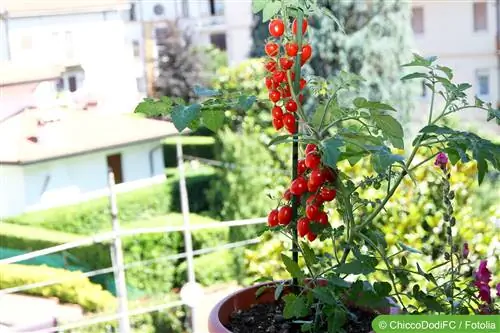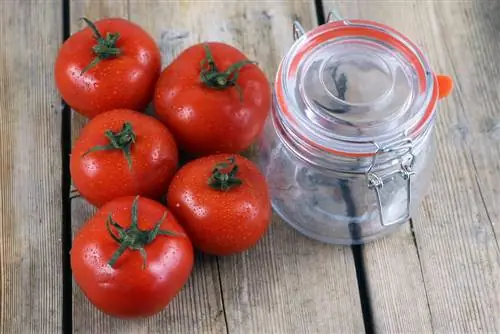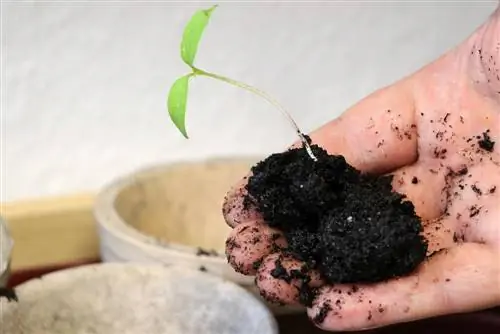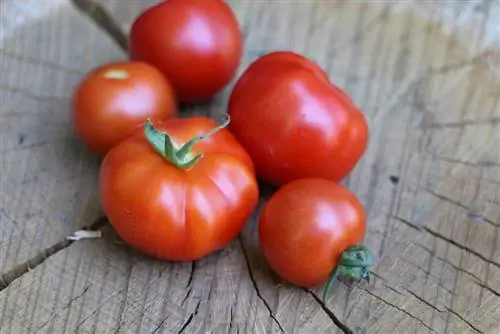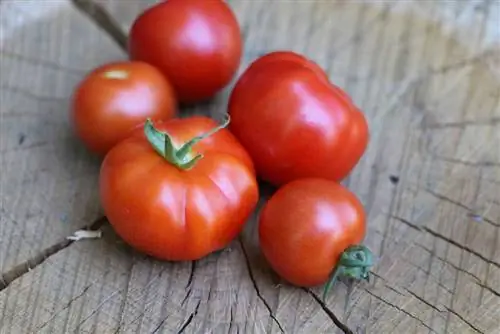- Author admin [email protected].
- Public 2023-12-17 03:39.
- Last modified 2025-01-24 12:45.
Most varieties of tomatoes sold in supermarkets have been harvested green. Therefore they don't taste very aromatic. In order to always have fresh and tasty tomatoes in the house, you should cultivate them yourself. This can be done not only in your own garden, but also on the balcony. To ensure that there are always enough balcony tomatoes available and that they ripen quickly, you should choose cocktail or balcony tomatoes. The trade has already adapted to the trend and has specially bred tomato varieties that are particularly good on the balcony.
Growing and cultivation
Balcony mats are very sensitive to frost. They may therefore only be brought onto the balcony after the Ice Saints. Since tomatoes have a very high nutrient requirement, the plant containers in question must not be too small. A planter that can be selected for growing tomatoes should therefore have a volume of at least 15 liters. Small tomato plants can be purchased from a gardener at planting time, but you can also grow them yourself from seeds. Cultivation can begin from February/March. For cultivation you need old egg cartons or spring pots from the gardener. These are filled with potting soil before the seeds are placed in the ground according to the instructions. In order for tomato seeds to germinate properly, they need a warm, sunny place and water regularly (about every 2 days). Tomato plants cannot tolerate waterlogging in any growth phase, so excess water should always be able to drain away unhindered.
If the tomato seeds have not been placed individually in cultivation pots, the plants will have to be pricked out after a while. Pricking must be done very carefully. If several plants are very close together, it can be assumed that the roots are also interwoven. The separation should be done very carefully so that the sensitive root system is not damaged. Otherwise the pricked plants could wither. Once the tomato plants are 15 to 20 centimeters tall, they can be repotted into a large pot that has a volume of at least 15 liters. The potting soil must be very rich in substrate so that the plants are supplied with enough nutrients. Large balcony boxes can also be planted with tomato plants; hanging varieties are particularly suitable here. Not only do they give a rich harvest, they also look very decorative.
Plant Care
Balcony mats always require a sufficient amount of water, but without the formation of waterlogging. After a few weeks in the new pot, the tomato plants should be fertilized. Special tomato fertilizer is available in stores that is tailored precisely to the needs of the plants. Fertilizing with compost or other types of organic fertilizer may be a little difficult when growing on a balcony, as there is usually not enough additional space in the planters.
In order for tomato plants to grow well and produce enough fruit, they must be pruned regularly. When pinching out, side shoots that keep forming between the trunk and leaves (directly in the axis) are simply broken away with your fingers. The plant parts removed during thinning can simply be placed next to the plant in the pot. They can be seen as a type of fertilizer. Once tomato plants are over 10 inches tall and are not a trailing variety, they will need to be supported or tied. Trellises are available commercially in a wide variety of sizes. When fixing the plant to the trellis, care should be taken not to tie the plant too tightly. The shoots must under no circumstances be injured. Tying tomato plants is very important, otherwise they would collapse under their own weight and the burden of the fruit.
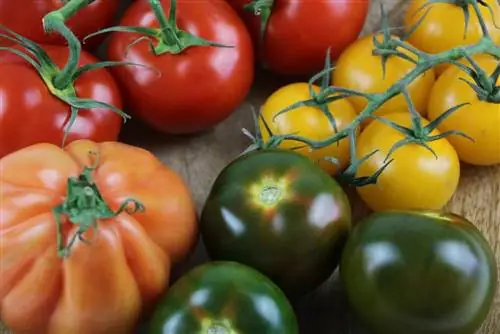
Tomatoes are very sensitive to unfavorable weather conditions. Rain, wind and hail damage a tomato plant faster than you would imagine. The location of the tomato plants should therefore be chosen so that the plants can receive enough sun, but are protected from wind and rain. With a little luck, if the plants are very protected, balcony tomatoes can be harvested until the first frost. If frost is forecast in late autumn and there are still a few green tomatoes hanging on the vine, they can be harvested and wrapped in newspaper. Tomatoes are nightshade plants and ripen in the dark. After a few days, the green balcony tomatoes in the newspaper will have ripened and can be eaten.
Crop rotation
Since balcony tomatoes can be replanted in pots every year, there is of course no need to pay attention to crop rotation. Nevertheless, after each harvest, the potting soil should be destroyed along with the dried plants and the flower pots or balcony boxes should be cleaned meticulously. Washing with a detergent solution, followed by a caustic soda solution, should be sufficient to remove any possible pathogens. Flower pots and balcony boxes should be kept dry over the winter so that no mold spores can settle. If necessary, the respective planter must be cleaned again after winter before replanting. The trellises used can be used again every year, but should also be cleaned before storage. Any remaining soil at the end of the trellis should be removed.
Diseases
Balcony growers can suffer from various fungal diseases if the weather is too humid. The best known is brown or late blight. The fruits of tomato plants that are affected by brown blight or late blight should no longer be consumed. In all cases, dry spot disease, brown blight, late blight and powdery mildew are fungal diseases. If these have occurred, it is particularly important to clean the pots and climbing aids meticulously after the season. It is also often important to consider whether to place pots with tomato plants directly against the wall of the house. There they are protected from wind and rain and benefit from the heat radiation from the house wall overnight.
Recommended varieties
Various tomatoes can be cultivated as balcony vegetables. So-called balcony tomatoes are most suitable. These are usually upright growing or hanging bush or vine tomatoes with a height of 30 to 100 cm.
Planting Tips
Balcony boxes or planters made of clay, wood, plastic or Eternit are suitable as planters. Even substrate bags or PE bags can be used. It is important that all containers used have at least one drainage hole in the bottom where excess water can drain away. Water storage vessels must have an overflow so that waterlogging does not occur after rainfall or watering.
The vessels must be sufficiently large, better too big than too small. In order to deliver good yields, the plant needs sufficient root space. This also ensures a firm footing. Individual containers from 15 liters are suitable for tomatoes. The right plant substrate is important. It must be nutrient rich. Potting soil is well suited. It is more fertilized than seed soil. Since tomatoes are heavy feeders, the fertilizer supply doesn't last very long. After growing, the plant needs to be fertilized regularly. Special tomato fertilizers are well suited for this. You can also use organic fertilizer such as compost or horn shavings or mineral fertilizer.
When choosing the right tomato varieties, you should make sure that they are suitable for keeping on balconies. Breeders have developed a lot of new varieties for this purpose. It doesn't always have to be cocktail tomatoes.
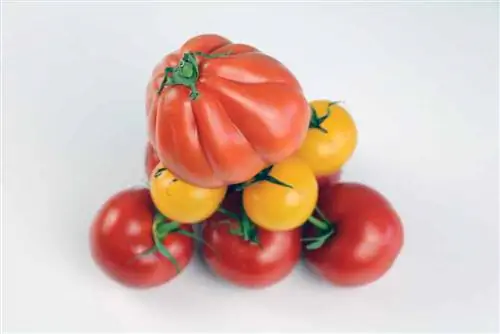
There is also a risk of frost on the balcony, which is why the plants should only be put outside after the Ice Saints. Even in May it can still be cold, so it's better to put the buckets against the wall of the house. A balcony sheltered from the wind is more suitable than a drafty one. In a windy area, the plants need to be particularly well tied and supported. The plants enjoy lots of sun. But you don't need them all day long.
In contrast to single-shoot tomatoes, balcony tomatoes are grown in multiple shoots. This means that removing the side shoots, known as thinning, is not necessary.

